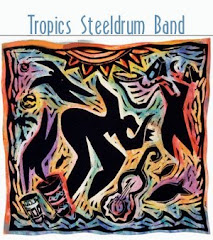| | |
| Heron was the first black person to play professional football in the US and Scotland |
Signed by Celtic F.C. in 1951, Heron, a striker, scored a goal on his debut.
“Right now he is Scottish football’s Golden boy” said a newspaper of Heron, who was discovered by Celtic while on a tour of the US in 1951.
“Fifty thousand supporters hail him as the greatest thing seen at Celtic Park since goalposts.”
Heron, who was extraordinarily quick, was called the ‘Black Flash’ by Celtic fans.
For Heron, who had spent most of his sporting career at small clubs in the US, the chance to play for Celtic was a dream come true.
“Gee, I was tickled,” the Jamaican told a Scottish newspaper in 1951 after arriving at Celtic from Detroit where, after a stint in the Canadian armed forces during the war, he took a job in an auto plant while playing football.
“Glasgow Celtic was,” Heron said, “the greatest name in football to me.”
America
In the US, Heron had played for a host of teams.
In 1946, his team, the Wolverines, won the North American Professional Soccer League’s championship.
The Jamaican - the only black player in US professional football at the time - was the league’s top goal scorer with 29 goals. Two years later he was on the US’ All Star team.
| | |
| Top billing for the football great |
In a 1947 profile, Ebony magazine described Heron as the ‘Babe Ruth of soccer.’
“The ancient Old-World game of soccer boasts a New-World star,” Ebony said.
All-rounder
Gillie Heron was a sporting renaissance man.
In 1940, he was the Golden Gloves welterweight champion of Michigan. He played pro cricket in Scotland and was a top long jumper, high jumper and sprinter, as well.
As a schoolboy in Jamaica, Heron defeated Herb McKinley, who would go on later to become a world record holder and an Olympic gold medalist.
In 1937, aged 15, he led his Jamaican school, St George’s, to victory in the Manning Cup and later won a place on the Jamaica Football Association XI, which in 1952, played a series against the Caribbean Combined XI, which featured Trinidad star Delbert Charleau.
Still, though he’d been a success in the Caribbean and the US, Gillie Heron’s time in Scotland was brief.
He stayed only a year at Celtic, playing only four first team games and scoring only twice.
It’s claimed the club felt Heron was not robust enough for the Scottish game with its tough tackles and rough play.
He was criticized in newspapers, according to sports historian Phil Vasili, as "lacking resource when challenged."
Heron was demoted to the reserves. And though he scored 15 times in 15 matches he left Celtic a year after he first arrived there, for the lowly Scottish side, Third Lanark.
In 1953, he moved to Kidderminster Harriers, a semi professional club in England.
There Heron got off to a good start, scoring “a goal worthy of inclusion in any FA text book” a newspaper reported.
Detroit
In 1954, Gillie Heron returned home to Detroit. With a family to support, he took a job on the assembly line at the Ford Motor Car Company. Any dreams he had of football as a career were over.
There are several reasons why Gillie Heron’s time at Celtic was so brief.
He was far too stylish a player for the rough and tough football played in Britain in the 1950s and aged 29 when he arrived at Celtic, Heron was probably past his best.
Frank Dell’apa, an American sportswriter, believes Heron was unlucky to have been born when he was.
Today Heron, whom he calls ‘the forgotten pioneer of US soccer’, would, Dell’apa says, have had a long career at Celtic and then earned a good living playing in the North American Soccer League.
| | |
| The forgotten pioneer of US soccer? |
Dell’apa also suggests that Gillie Heron was hamstrung by racism.
Though Heron was the top goal scorer in the North American Professional Soccer League in 1946 he was paid only 25 dollars a game compared with the 100 dollars a game paid to white player Pete Matevich, who scored far fewer goals than Heron.
Gayle Heron, who along with the singer Gil Scott-Heron, is one of Gillie Heron’s four children, said her father was not bitter he received so little recognition.
“He knows he was a pioneer,” she says.
Leslie Goffe’s book on Gillie Heron and Gil Scott Heron, will be published in 2010.
--BBC Caribbean.com



No comments:
Post a Comment